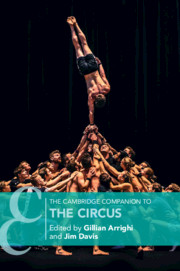Book contents
- The Cambridge Companion to the Circus
- Cambridge Companions to Theatre and Performance
- The Cambridge Companion to the Circus
- Copyright page
- Contents
- Figures
- Contributors
- Acknowledgements
- Timeline
- Introduction
- Part I Transnational Geographies of the Modern Circus
- Part II Circus Acts and Aesthetics
- Part III Circus
- Chapter 11 Circus and Somatic Spectacularity on Stage in the Variety Era
- Chapter 12 Becoming an Art Form
- Chapter 13 Risky Play and the Global Rise in Youth Circus
- Chapter 14 Social Circus
- Part IV Circus Studies Scholarship
- Bibliography
- Index
- References
Chapter 13 - Risky Play and the Global Rise in Youth Circus
from Part III - Circus
Published online by Cambridge University Press: 22 June 2021
- The Cambridge Companion to the Circus
- Cambridge Companions to Theatre and Performance
- The Cambridge Companion to the Circus
- Copyright page
- Contents
- Figures
- Contributors
- Acknowledgements
- Timeline
- Introduction
- Part I Transnational Geographies of the Modern Circus
- Part II Circus Acts and Aesthetics
- Part III Circus
- Chapter 11 Circus and Somatic Spectacularity on Stage in the Variety Era
- Chapter 12 Becoming an Art Form
- Chapter 13 Risky Play and the Global Rise in Youth Circus
- Chapter 14 Social Circus
- Part IV Circus Studies Scholarship
- Bibliography
- Index
- References
Summary
Youth circus opportunities are part of a global expansion in circus arts practices. Although defined with different nuances in different locations, Youth circus is generally accepted to include any youth participating in learning circus skills for non-professional reasons, including recreation, physical education, and social contexts. Anecdotes describing the transformative and beneficial effects of learning circus abound. Research indicates that the introduction of circus arts to a broad youth population has been shown to increase motor competence, motor confidence, physical literacy, self-determination, and encourage risk assessment. This chapter describes how research describing the benefits from participating in youth circus can be understood within the framework of risky play. When engaging in risky play, youth test their own physical and emotional limits in order to develop strategies that will benefit them when encountering future risks. The opportunity to participate in risky play enables youth to learn to trust themselves and develop awareness of their strengths and weaknesses. Learning circus offers a context for diverse, incremental, and individualized risk-taking, in environments where instructors and equipment provide risk-management. Looking at research results through the lens of risky play contributes to a description of youth circus as an enriching activity.
- Type
- Chapter
- Information
- The Cambridge Companion to the Circus , pp. 203 - 215Publisher: Cambridge University PressPrint publication year: 2021
References
Further Reading
- 2
- Cited by

